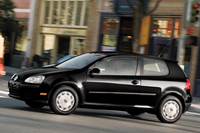2007 Volkswagen Rabbit 4-door Hatchback Review
THE AUTO PAGE
By
JOHN HEILIG
2007 Volkswagen Rabbit 4-door hatchback
SPECIFICATIONS:Engine: 2.5-liter I-5
Horsepower/Torque: 150 hp @ 5000 rpm/170 lb.-ft. @ 3750 rpm
Transmission: 5-speed manual
Wheelbase: 101.5 in.
Length x Width x Height: 164.9 x 68.3 x 56.7 in.
Tires: P195/65R15
Cargo volume: 41.8 cu. ft.
Economy: 22 mpg city/30 mpg highway/22.6 mpg test
Price: $19,845 (includes $639 destination charge)
Assets – As a direct descendant of the original Beetle, the Rabbit is better in all ways. Compact dimensions belie comfort and practicality.
Debits – Even for a five-cylinder, the engine is noisy. No arrow to show which side of car the fuel filler is located.
Way back in 1976, Volkswagen replaced the venerable Beetle with something called the Rabbit. This car was marketed as the Golf all over the globe, but in the United States it was to be the Rabbit.
Unlike the rear-engined air-cooled Beetle it replaced, the Rabbit was a front-wheel drive car with a water-cooled engine. Had VW gone bonkers?
As we all know now, the Rabbit and its iterations were just what VW needed. Its name was soon changed to Golf to reflect its nomenclature around the world. It grew into the Jetta and spawned other variations, but the hatchback Rabbit/Golf has remained pretty close to its original roots for 30 years, much in the same way the original Beetle did.
Now, Volkswagen has gone into the renaming game again and has renamed the Golf the Rabbit. With the name change comes a significant style change as well. Oh, the Rabbit is still a hatchback four-door (the GTI is the two-door coupe version), but it’s more aerodynamic and more modern looking. It almost scares me to look at the original Rabbit and compare it to the present version and see how far VW has come.
There’s been a significant change under the hood as well. After years with four-cylinder engines, the Rabbit is now powered by an inline five-cylinder that develops a healthy 150 horsepower. This isn’t going to get you in trouble because it’s so overpowering, but the engine is a nice match for the car. It’s akin to stuffing a V8 into a compact sedan and then taking advantage of the bigger engine’s torque to make driving more pleasurable, if not faster.
Our tester had a 5-speed manual transmission. I felt it was best using only the first four, except on Interstate runs. With the four gears, acceleration was good and there was no need to constantly shift down from fifth whenever I needed a jolt of power.
Handling was good for a small hatchback. As a direct descendant of the Beetle, one wouldn’t expect great handling. If you want more, you can always get the GTI.
Creature amenities are abundant. My wife and I loved the heated front seats, especially on long rides. In addition, the seats are comfortable, with decent side support. Rear seat legroom is very good, but the center hump is fairly large, so the Rabbit is really a four-seater, even if it claims to be a five-seater. A nice feature is the low location of the rear headrests in “normal” position that doesn’t obstruct the driver’s rearward vision. When there are passengers back there, they can raise the headrests to a more comfortable spot.
I was impressed with the trunk. It’s a fairly decent size for a compact car, but the rear seatbacks fold to increase cargo capacity to more than 40 cubic feet. There’s also a “pass through” between the two rear seats, so that if you’re carrying skis or fishing poles, you can use the pass through to carry them inside the car.
There’s a space safer spare tire with cargo boxes around it for added storage.
Inside there are numerous storage compartments; a cubby at the bottom of the center stack; an average glove box, a good-size center console that held five CDs. The Rabbit has four cupholders, two located way up front at the bottom of the center stack and two in the center. Also, there are cup/bottle holders in the doors that are ideal for water bottles.
Our tester had the standard issue Volkswagen sunroof that has its own quirky way of operating, but it works.
Under the hood, the oil dipstick is conveniently located right in front, but the filler cap is in the center where you can spill oil on the engine cover if you’re not careful. I liked the gas strut that held the hood open.
The Volkswagen Rabbit doesn’t have the charm of the original Beetle it replaced, but it is a far, far better car.
© 2006 The Auto Page Syndicate



